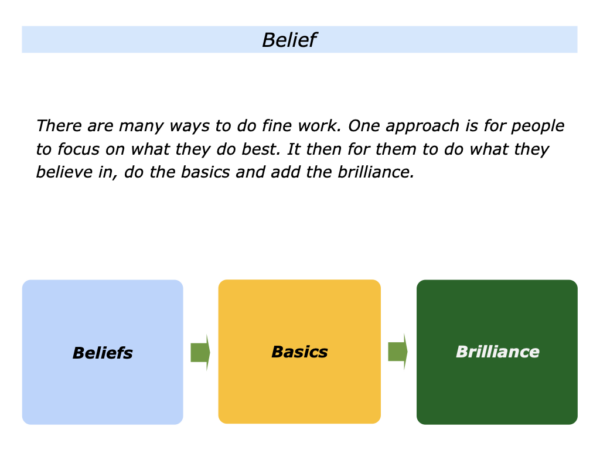
There are many ways for people to do fine work. One approach is for them to focus on what they do best. It is then for them to do what they believe in, do the basics and add the brilliance.
This article describes on how people can apply this approach to building brilliant teams. But the approach can also be followed in other situations.
Imagine that you lead a team. You can start by inviting people to focus on the team’s strengths and what it does best.
If you wish, invite them to do following exercise. They can clarify the specific activities – the tasks, projects and other activities – in which they believe the team has the ability to deliver As rather than Bs or Cs.
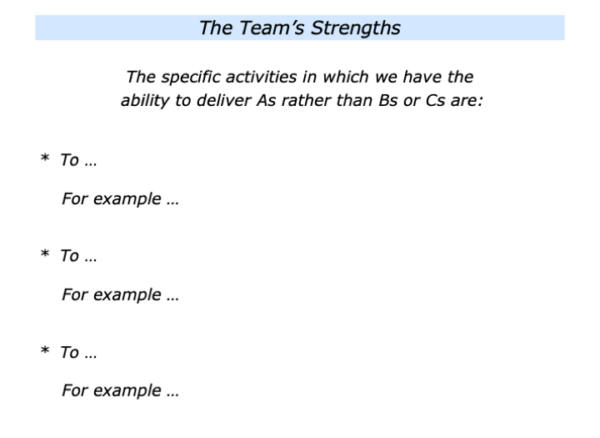
Imagine that people have done this exercise. You can then move on to the next stage.
The Beliefs
Belief is crucial. People work best when they believe in what they are doing. They also need to believe that – providing they do their best – they stand a chance of achieving their goals.
Charismatic leaders can sometimes inspire people to believe in themselves, but real belief must come from within. People need to develop a gut belief that they can reach their goals.
How to take this step? One approach is to invite people to revisit their positive history. It is to invite them:
To clarify the times when they have performed brilliantly in the past;
To clarify what they did right then – the principles they followed and how they translated these into action – to perform brilliantly;
To clarify how they can follow these principles – plus add other skills – to perform brilliantly in the future.
People are more likely to believe they can do something when they build on their successful patterns. It may be, of course, that they need to add other skills to achieve certain goals.
Imagine that people in the team are aware of their strengths and successful patterns. It is then time to help them to clarify what they believe the team can achieve.
Belief works best when people base it on what they can control rather than what they can’t control. People can control their attitudes, application and professionalism. They can’t control certain outside factors, though they can try to influence these issues.
Bearing in mind what the team can control, invite each of the individuals in the team to write Post-it Notes under the following headings.
Can Achieve
The specific things that I believe the team can achieve are …
Maybe Can Achieve
The specific things that I believe the team maybe can achieve are …
Probably Can’t Achieve
The specific things that I believe the team probably can’t achieve are …
Give people 15 minutes to write their Post-its and emphasise that you want people to be truthful. It is not about people pretending they think the team can achieve certain things or telling others they are wrong in their views.
Later there will be time to build on what people have in common and set the future direction. For the moment, however, invite each person to do the following exercise.
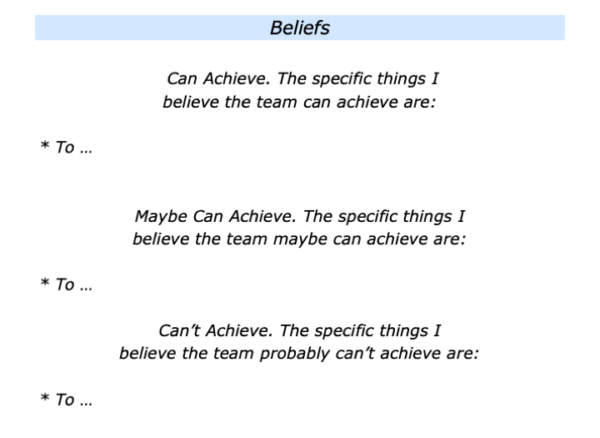
When people have finished, invite each person to go up in turn and put their Post-it Notes under the respective headings. Ask people to give examples regarding what they have written.
Looking at what people have written, begin clarifying the team’s shared beliefs. Facilitate a discussion around the main headings.
The discussion is to be conducted in a spirit of enquiry, rather than telling people they must believe. Make provisional agreements about what comes under each of the headings. You can then move on to the next stage.
Clarifying The
Team’s Shared Beliefs
Imagine that you have completed the earlier exercise. It is now time to agree on the shared beliefs. When doing this it can be useful to explore the following themes.
What are the things that people believe we can achieve? Do we have the ability to translate these into doing the basics and delivering brilliant results?
If we do not have the ability, what can we do to increase the chances of success? Do we need:
To recruit more people who can help us to achieve the goal; b) to be more selective and focus on fewer things that we believe we can achieve;
To make sure we have the support required to achieve the goals?
Finally, are there any ways we can convert some of the ‘maybe can achieve’ column into the ‘can achieve’ column?
Imagine you have had a discussion on these themes. You can then complete the following exercise.
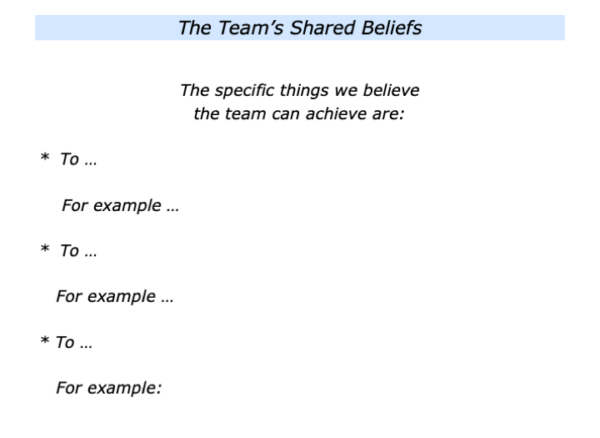
Brilliance – Clarifying The
Team’s Picture Of Success
Great teams are made-up of people who believe they can achieve a particular goal. If there are people in the team who do not share this belief, then there are two options. You either get people who share the belief or you can change the goals.
Let’s assume that you are happy with what you believe the team can achieve. The next steps will be:
To clarify people’s view of brilliance;
To clarify the real results they will have delivered by a certain date that will show they have done the basics and added the brilliance;
To translate this view of brilliance into the team’s picture of success.
Imagine that the team has created a provisional picture of success. You can take it away and, perhaps with a few key people, do a reality check. When doing so, it can be useful to ask yourself the following questions.
Bearing in mind what we can control, what are the chances of delivering this picture of success? How would we rate the chances on a scale 0-10?
What can we do to improve the rating? Do we need to add people, move people around or replace people? Do we need extra resources? What can we do to increase the chances of success to 8+/10?
You and the team will have your own approach to clarifying and finalising the picture of success. Whatever approach you use, it may resemble something like the following framework.
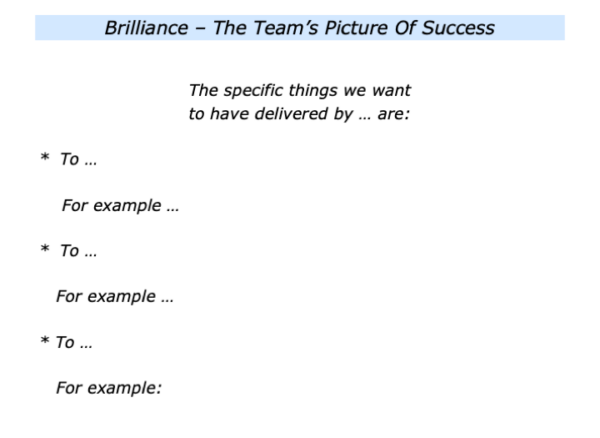
The Basics
Great teams focus on what they believe they can achieve. They then keep doing the basics required to achieve their goals.
Different teams will, of course, need to perform different basics to reach their desired goals. The principles they follow will depend on whether they work in sports, business, hospitality, medical care, therapy, technology or whatever.
Great teams implement the right principles with the right people in the right way. So it is vital to ensure you have the right people in the right places. You then stand a much greater chance of building a successful team.
How can you encourage people to keep doing the basics? One approach is to supervise the tasks. But this often has only a short-term effect.
Another approach is to manage by outcomes. You can explain the team’s goals – the outcomes it must deliver – and then involve people in clarifying the basics.
This was the approach was taken by one leader I worked with who helped his team to focus on the basics and the brilliance. The leader explained what happened in the following way.
“One year ago my team was in a difficult state. Some people were in love with doing the attractive stuff but they did not pay enough attention to the basics.
“This meant I spent lots of time supervising their tasks. This wasn’t sustainable in the long term, so I made some key decisions.
“First, I decided who might be able to deliver the required professional standards.
“Looking at each person in turn, I rated their potential on a scale 0–10. I kept the people who had the attitude and ability to reach 7+/10 and replaced those who didn’t.
“Two left because they had a poor attitude, one because their skills just did not fit. This was difficult, but it was necessary for the team.
“We also did our best to help people to move on in a good way. This approach sounds tough, but the alternative was to continue supervising people. This would not benefit anybody.
“Second, I then involved everybody in clarifying the basics and the brilliance.
“Gathering people together, I shared the overall goal. Each person was invited to write Post-it Notes regarding what they saw as the basics that must be done to deliver the goods.
“People went up in turn and put these on a flip chart. Eventually we agreed on what must be done to deliver the basics.”
You will have your own method for helping a team to focus on doing the basics. If you wish, however, you can adopt the following approach.
Start by reminding people of the things that they believe the team can achieve. Bearing these themes in mind, ask people to explore how they can translate these beliefs into action.
You can follow the approach mentioned earlier. Invite people to write Post-it Notes describing what they believe people in the team can do to always deliver the basics. Here is the exercise.
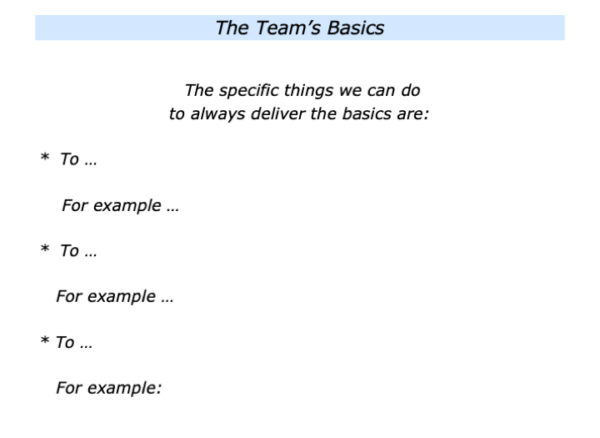
The Brilliance
Great teams keep doing the basics and then, when appropriate, add the brilliance. Different teams do this in different ways. The leader mentioned earlier explained his approach in the following way.
“I asked my team to focus on adding that touch of class. Looking back, I gave concrete examples regarding when people had taken this step.
“Frequently they had done things that were a win-win. They had created a win for the customer and a win for the company.
“Sometimes the touch of class had been a creative breakthrough. Sometimes it had been providing a great piece of customer service.
“Frequently it involved people showing the personal touch and helping our customers to succeed. This made the customers more likely to do business with us in the future.
“Each person was invited to describe how we could add that touch of class in the future. People wrote their Post-it Notes and put them on a flip chart.
“Many of the ideas involved getting close to customers, understanding their agendas and doing that bit extra. We then agreed on the ways people could add that touch of class in the future.”
There are many models for building fine teams. One approach is to get people to build on their beliefs, keep doing the basics and, when appropriate, add the brilliance.
If you wish, invite the people in your team to tackle the final exercise on this theme. They can describe the specific things they can do to add the brilliance. You can encourage people to keep doing these things and deliver ongoing success.
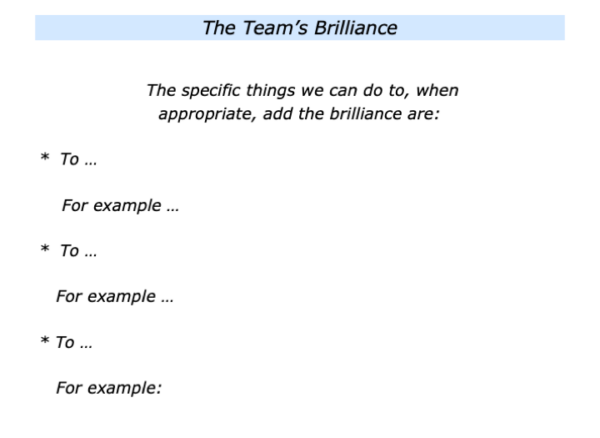






Leave a Reply